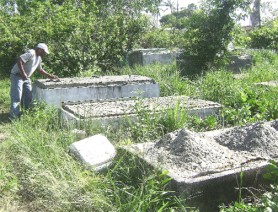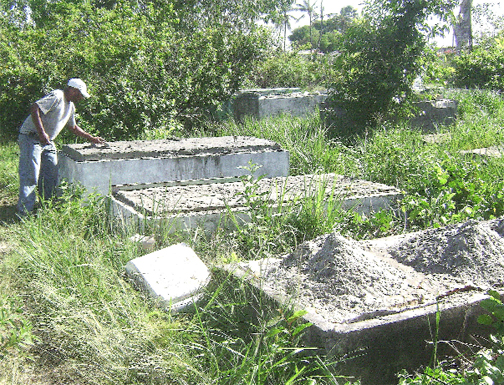“They dig into the tombs of the recently buried to retrieve valuables and human parts for witchcraft or export and some clean out the tomb to sell the spot to another bereaved family.”

These are the real reasons, Stabroek News was told during a visit to Le Repentir Cemetery yesterday, for the destruction of tombs in the burial ground. None of the informants to whom this newspaper spoke was of the view that the damage to tombs had been caused by vandals looking for steel rods, although this was one of the reasons given last week for the Prime Minister’s decision to ban the trade in scrap metals.
A local scrap iron dealer, one of many in the business who is feeling the effects of a recent ban on the trade, volunteered his services to repair extensive damage to tombs in the cemetery, and his workers could be seen yesterday engaged in repair work.
Most of the damaged tombs are located on the western side of the cemetery, aback of the jungle-like section of Le Repentir, and according to one man who participated in the reconstruction exercise yesterday, destroying tombs is a night-time activity. He said that old tombs and graves bearing no headstones were particularly vulnerable.
Persons would enter the cemetery, equipped with the necessary tools, tap the ends or corners of the tombs to make a small indentation so that the poisonous fumes within could escape. After a few days they would return to the scene to “clean out the tomb” so that a “new buyer,” for example, could illegally be allocated the spot, or to remove the body parts of the dead. If the deceased had been recently buried, Stabroek News was informed, the parts would be sold.
As regards the latter, it was alleged that the body parts were exported to another country.
Another person at the scene said that “Some of the funeral homes are part of this thing [the illegal sale of burial plots],” since “people does make money from just one spot; more than one person could be buried in the same spot.” He said there had been instances where more than one family unrelated to each other had turned up to pray at a graveside because the plot had been resold.
The man told this newspaper that a fee of $20 000 was usually paid to the legitimate authorities for a spot in the cemetery, but those authorities “don’t have to know what going on here,” since the persons involved in the racket were paid sums of money to “arrange a spot” for those destined for the great beyond. City Mayor Hamilton Green when contacted yesterday afternoon, told Stabroek News that vandalism in the cemetery was an ongoing issue, and City Hall with its limited finances had tried to monitor the situation. Mayor Green said that constables had been stationed at Le Repentir, but the area was “not an easy place to monitor.”
He said the authorities had made arrests following reports of vandalism in the area,” as it was an ongoing “social problem,” but suggested that it might be the work of persons of unsound mind. He was unaware, he said, of the reconstruction work being undertaken by the scrap metal dealer, but noted that the city was open to receiving assistance from the public in upkeeping the cemetery.
Stabroek News was given a tour of the work completed by the scrap metal dealer who started to renovate the tombs on Saturday morning while clearing the bushes in the most affected section at the back of the burial ground. The group of men hired by the dealer was busy reconstructing the tops of several tombs; damage done to the tops of tombs in that part of Le Repentir was widespread.
This newspaper understands that Public Works Minister Robeson Benn visited Le Repentir during the course of last week and asked about the presence of the rails surrounding the tombs, if indeed the intent of the vandals was to retrieve metal. Rails around tombs were still in evidence yesterday although there were huge cracks in the tombs themselves.
The workers hired by the dealer took this reporter along a trail leading to the periphery of the cemetery where dozens of tombs without tops lay open to the elements. One of the men opened a tomb and pointed to a hammer and screwdriver which he said had been left behind by the pillagers. The instruments appeared rusty and according to the man, “These man them been removing this woman teeth, she had to have gold teeth.” The tomb appeared fresh, and the name of the deceased appeared to have been obliterated by the vandals. He said the destroyers would bury the remains of the deceased in the nearby canals, which Stabroek News observed were covered by thick bushes. The man pointed to a track leading into the bushes, where the group stumbled upon another set of destroyed tombs.
The man told this newspaper that he once had worked in the cemetery as a mason and he had been involved in preparing tombs for the dead. He could not say who his employer was, but according to him, he had been “just trying a hand in the mason trade.” Asked his opinion about the ban on the scrap iron trade being blamed in part for the destruction of tombs, the man said that he did not believe the reason held, since according to him, not many tombs were built with steel rods or metal bars.
The sides of a tomb were made of concrete blocks plastered with cement, he explained; the foundation utilized some 2-3 pieces of steel rod while the top of the tomb was constructed with several boards plastered over with cement.
“How much of them metal bars you think them man could get from here, and ask yourself who in them right mind will come in here and waste they time over couple piece of steel rod,” he queried. He said if the intent of the vandals was to retrieve the steel or metal rods, “why they left all those rails around the tombs?”
Another man at the scene told Stabroek News that the cemetery needed to be cleaned. The thick bushes which hid the tombs in the affected section should be cut. “This thing going on long now,” he observed, “only thing is the wrong reason the public hearing.” He said he could not recall how many persons retrieved steel rods for the scrap metal trade.
Late last week, the Government Informa-tion Agency (GINA) in a statement said that Prime Minister Samuel Hinds had placed a ban on the scrap iron trade, giving as the reason damage done to state and private property as well as to tombs. GINA stated that persons had been complaining about the illegal activity taking place in Le Repentir, and in some cases the perpetrators had removed the metal bars holding up the concrete.
The release stated that the Prime Minister had been forced to close down the trade “to curb the problem that continues unabated” with the upsurge in vandalism of “various articles, private and state property and commercial and building sites, containing metal.”

